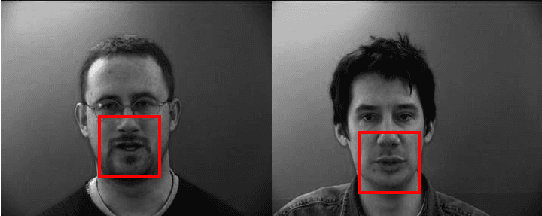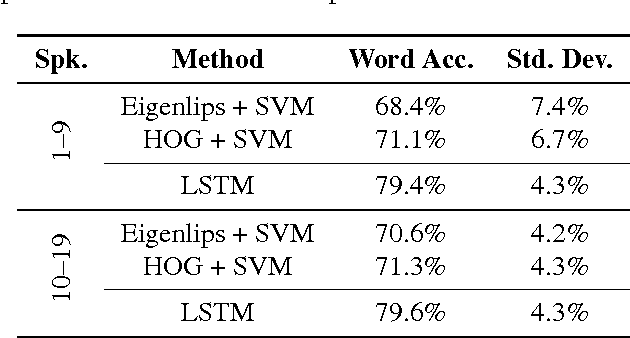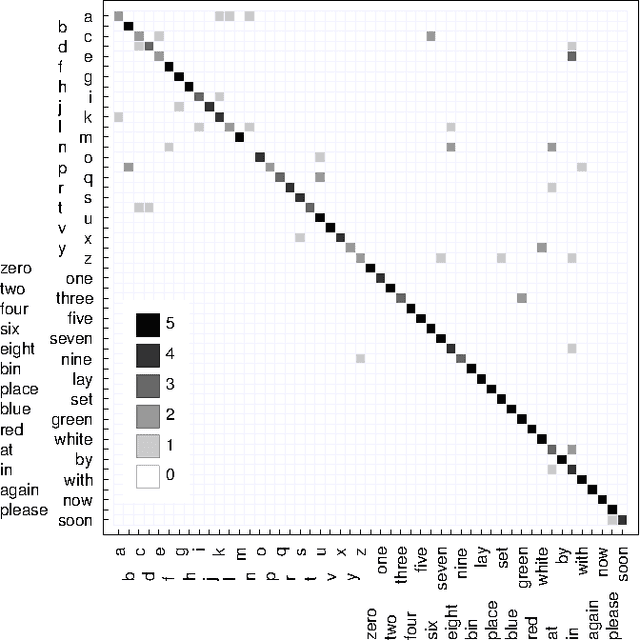Michael Wand
Accelerating the inference of string generation-based chemical reaction models for industrial applications
Jul 12, 2024Abstract:Template-free SMILES-to-SMILES translation models for reaction prediction and single-step retrosynthesis are of interest for industrial applications in computer-aided synthesis planning systems due to their state-of-the-art accuracy. However, they suffer from slow inference speed. We present a method to accelerate inference in autoregressive SMILES generators through speculative decoding by copying query string subsequences into target strings in the right places. We apply our method to the molecular transformer implemented in Pytorch Lightning and achieve over 3X faster inference in reaction prediction and single-step retrosynthesis, with no loss in accuracy.
Diff-ETS: Learning a Diffusion Probabilistic Model for Electromyography-to-Speech Conversion
May 11, 2024Abstract:Electromyography-to-Speech (ETS) conversion has demonstrated its potential for silent speech interfaces by generating audible speech from Electromyography (EMG) signals during silent articulations. ETS models usually consist of an EMG encoder which converts EMG signals to acoustic speech features, and a vocoder which then synthesises the speech signals. Due to an inadequate amount of available data and noisy signals, the synthesised speech often exhibits a low level of naturalness. In this work, we propose Diff-ETS, an ETS model which uses a score-based diffusion probabilistic model to enhance the naturalness of synthesised speech. The diffusion model is applied to improve the quality of the acoustic features predicted by an EMG encoder. In our experiments, we evaluated fine-tuning the diffusion model on predictions of a pre-trained EMG encoder, and training both models in an end-to-end fashion. We compared Diff-ETS with a baseline ETS model without diffusion using objective metrics and a listening test. The results indicated the proposed Diff-ETS significantly improved speech naturalness over the baseline.
Spreads in Effective Learning Rates: The Perils of Batch Normalization During Early Training
Jun 01, 2023Abstract:Excursions in gradient magnitude pose a persistent challenge when training deep networks. In this paper, we study the early training phases of deep normalized ReLU networks, accounting for the induced scale invariance by examining effective learning rates (LRs). Starting with the well-known fact that batch normalization (BN) leads to exponentially exploding gradients at initialization, we develop an ODE-based model to describe early training dynamics. Our model predicts that in the gradient flow, effective LRs will eventually equalize, aligning with empirical findings on warm-up training. Using large LRs is analogous to applying an explicit solver to a stiff non-linear ODE, causing overshooting and vanishing gradients in lower layers after the first step. Achieving overall balance demands careful tuning of LRs, depth, and (optionally) momentum. Our model predicts the formation of spreads in effective LRs, consistent with empirical measurements. Moreover, we observe that large spreads in effective LRs result in training issues concerning accuracy, indicating the importance of controlling these dynamics. To further support a causal relationship, we implement a simple scheduling scheme prescribing uniform effective LRs across layers and confirm accuracy benefits.
Nonlinearities in Steerable SO(2)-Equivariant CNNs
Sep 14, 2021



Abstract:Invariance under symmetry is an important problem in machine learning. Our paper looks specifically at equivariant neural networks where transformations of inputs yield homomorphic transformations of outputs. Here, steerable CNNs have emerged as the standard solution. An inherent problem of steerable representations is that general nonlinear layers break equivariance, thus restricting architectural choices. Our paper applies harmonic distortion analysis to illuminate the effect of nonlinearities on Fourier representations of SO(2). We develop a novel FFT-based algorithm for computing representations of non-linearly transformed activations while maintaining band-limitation. It yields exact equivariance for polynomial (approximations of) nonlinearities, as well as approximate solutions with tunable accuracy for general functions. We apply the approach to build a fully E(3)-equivariant network for sampled 3D surface data. In experiments with 2D and 3D data, we obtain results that compare favorably to the state-of-the-art in terms of accuracy while permitting continuous symmetry and exact equivariance.
Deep Non-Line-of-Sight Reconstruction
Jan 29, 2020



Abstract:The recent years have seen a surge of interest in methods for imaging beyond the direct line of sight. The most prominent techniques rely on time-resolved optical impulse responses, obtained by illuminating a diffuse wall with an ultrashort light pulse and observing multi-bounce indirect reflections with an ultrafast time-resolved imager. Reconstruction of geometry from such data, however, is a complex non-linear inverse problem that comes with substantial computational demands. In this paper, we employ convolutional feed-forward networks for solving the reconstruction problem efficiently while maintaining good reconstruction quality. Specifically, we devise a tailored autoencoder architecture, trained end-to-end, that maps transient images directly to a depth map representation. Training is done using an efficient transient renderer for diffuse three-bounce indirect light transport that enables the quick generation of large amounts of training data for the network. We examine the performance of our method on a variety of synthetic and experimental datasets and its dependency on the choice of training data and augmentation strategies, as well as architectural features. We demonstrate that our feed-forward network, even though it is trained solely on synthetic data, generalizes to measured data from SPAD sensors and is able to obtain results that are competitive with model-based reconstruction methods.
Progressive Stochastic Binarization of Deep Networks
Apr 03, 2019



Abstract:A plethora of recent research has focused on improving the memory footprint and inference speed of deep networks by reducing the complexity of (i) numerical representations (for example, by deterministic or stochastic quantization) and (ii) arithmetic operations (for example, by binarization of weights). We propose a stochastic binarization scheme for deep networks that allows for efficient inference on hardware by restricting itself to additions of small integers and fixed shifts. Unlike previous approaches, the underlying randomized approximation is progressive, thus permitting an adaptive control of the accuracy of each operation at run-time. In a low-precision setting, we match the accuracy of previous binarized approaches. Our representation is unbiased - it approaches continuous computation with increasing sample size. In a high-precision regime, the computational costs are competitive with previous quantization schemes. Progressive stochastic binarization also permits localized, dynamic accuracy control within a single network, thereby providing a new tool for adaptively focusing computational attention. We evaluate our method on networks of various architectures, already pretrained on ImageNet. With representational costs comparable to previous schemes, we obtain accuracies close to the original floating point implementation. This includes pruned networks, except the known special case of certain types of separated convolutions. By focusing computational attention using progressive sampling, we reduce inference costs on ImageNet further by a factor of up to 33% (before network pruning).
Investigations on End-to-End Audiovisual Fusion
Apr 30, 2018



Abstract:Audiovisual speech recognition (AVSR) is a method to alleviate the adverse effect of noise in the acoustic signal. Leveraging recent developments in deep neural network-based speech recognition, we present an AVSR neural network architecture which is trained end-to-end, without the need to separately model the process of decision fusion as in conventional (e.g. HMM-based) systems. The fusion system outperforms single-modality recognition under all noise conditions. Investigation of the saliency of the input features shows that the neural network automatically adapts to different noise levels in the acoustic signal.
* Published at ICASSP 2018
Improving Speaker-Independent Lipreading with Domain-Adversarial Training
Aug 04, 2017



Abstract:We present a Lipreading system, i.e. a speech recognition system using only visual features, which uses domain-adversarial training for speaker independence. Domain-adversarial training is integrated into the optimization of a lipreader based on a stack of feedforward and LSTM (Long Short-Term Memory) recurrent neural networks, yielding an end-to-end trainable system which only requires a very small number of frames of untranscribed target data to substantially improve the recognition accuracy on the target speaker. On pairs of different source and target speakers, we achieve a relative accuracy improvement of around 40% with only 15 to 20 seconds of untranscribed target speech data. On multi-speaker training setups, the accuracy improvements are smaller but still substantial.
Precomputed Real-Time Texture Synthesis with Markovian Generative Adversarial Networks
Apr 15, 2016



Abstract:This paper proposes Markovian Generative Adversarial Networks (MGANs), a method for training generative neural networks for efficient texture synthesis. While deep neural network approaches have recently demonstrated remarkable results in terms of synthesis quality, they still come at considerable computational costs (minutes of run-time for low-res images). Our paper addresses this efficiency issue. Instead of a numerical deconvolution in previous work, we precompute a feed-forward, strided convolutional network that captures the feature statistics of Markovian patches and is able to directly generate outputs of arbitrary dimensions. Such network can directly decode brown noise to realistic texture, or photos to artistic paintings. With adversarial training, we obtain quality comparable to recent neural texture synthesis methods. As no optimization is required any longer at generation time, our run-time performance (0.25M pixel images at 25Hz) surpasses previous neural texture synthesizers by a significant margin (at least 500 times faster). We apply this idea to texture synthesis, style transfer, and video stylization.
Lipreading with Long Short-Term Memory
Jan 29, 2016


Abstract:Lipreading, i.e. speech recognition from visual-only recordings of a speaker's face, can be achieved with a processing pipeline based solely on neural networks, yielding significantly better accuracy than conventional methods. Feed-forward and recurrent neural network layers (namely Long Short-Term Memory; LSTM) are stacked to form a single structure which is trained by back-propagating error gradients through all the layers. The performance of such a stacked network was experimentally evaluated and compared to a standard Support Vector Machine classifier using conventional computer vision features (Eigenlips and Histograms of Oriented Gradients). The evaluation was performed on data from 19 speakers of the publicly available GRID corpus. With 51 different words to classify, we report a best word accuracy on held-out evaluation speakers of 79.6% using the end-to-end neural network-based solution (11.6% improvement over the best feature-based solution evaluated).
 Add to Chrome
Add to Chrome Add to Firefox
Add to Firefox Add to Edge
Add to Edge